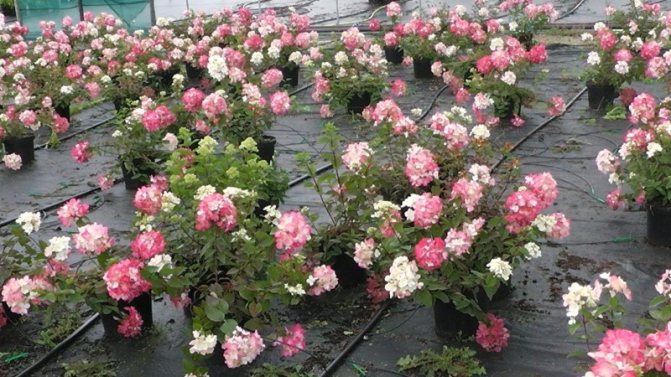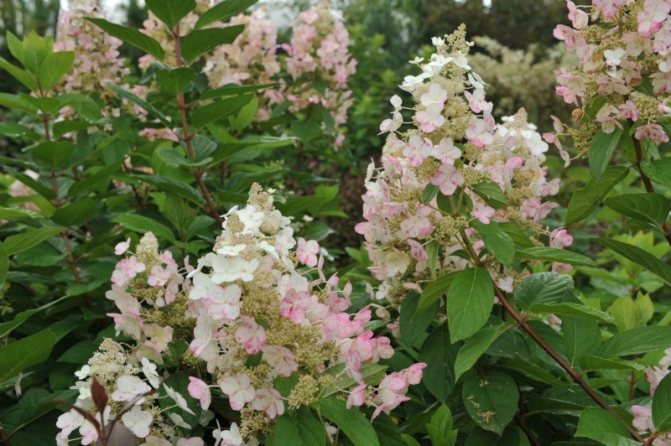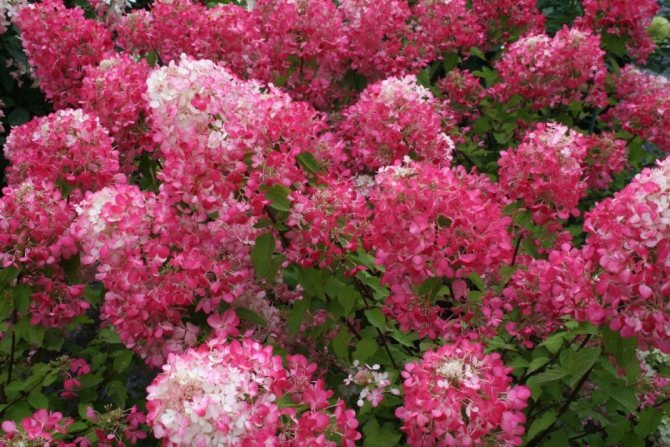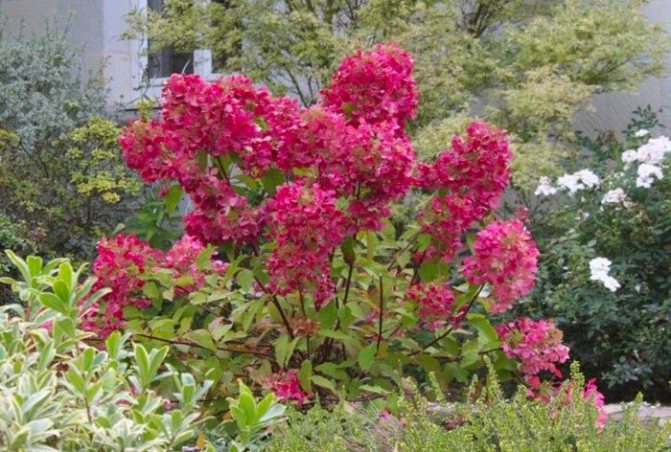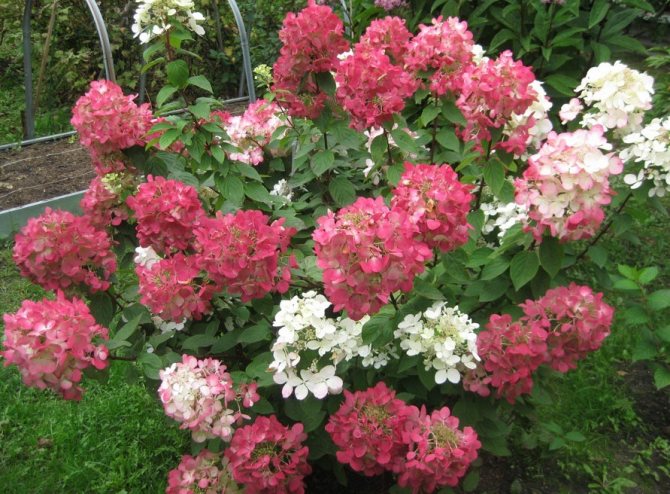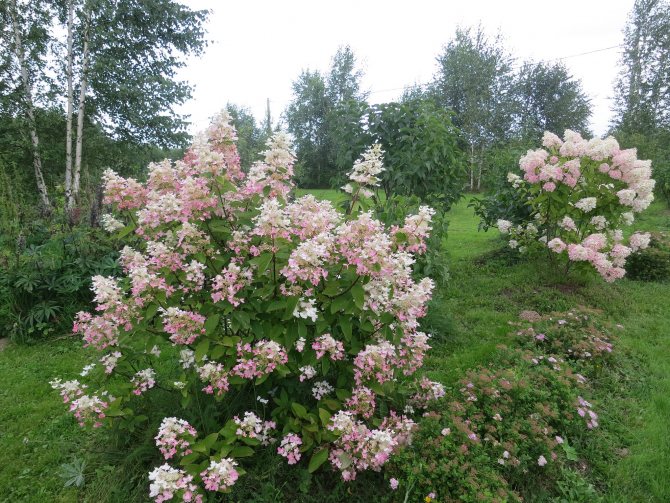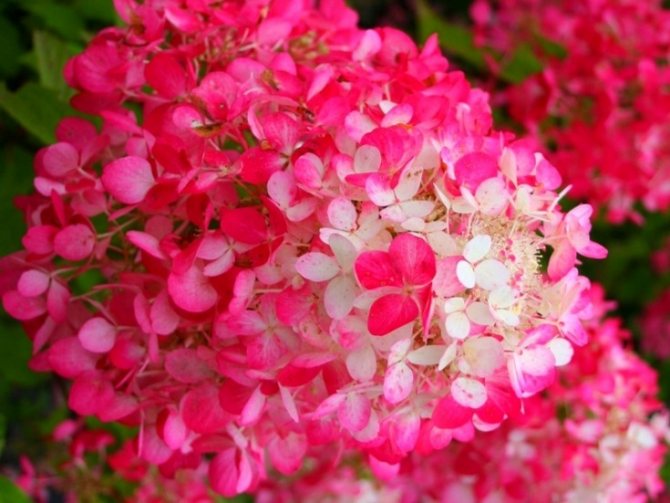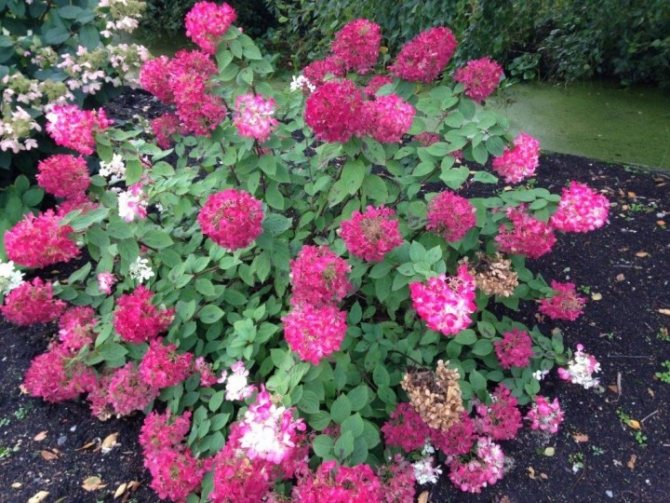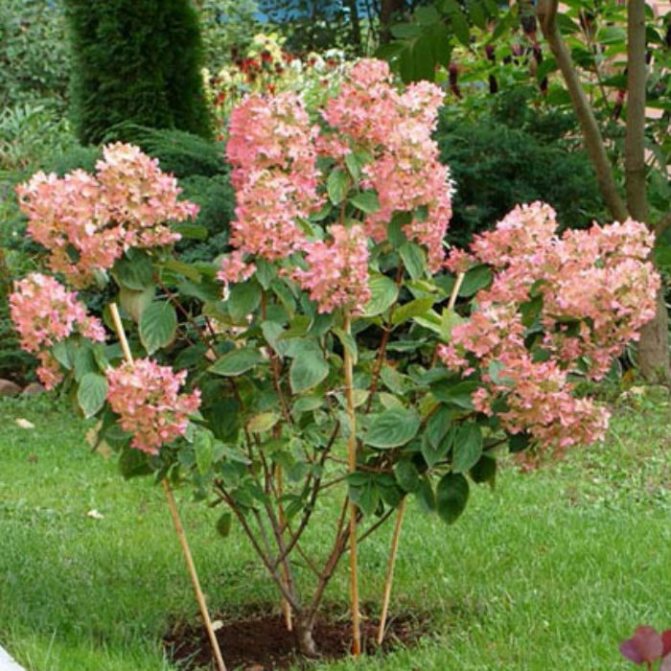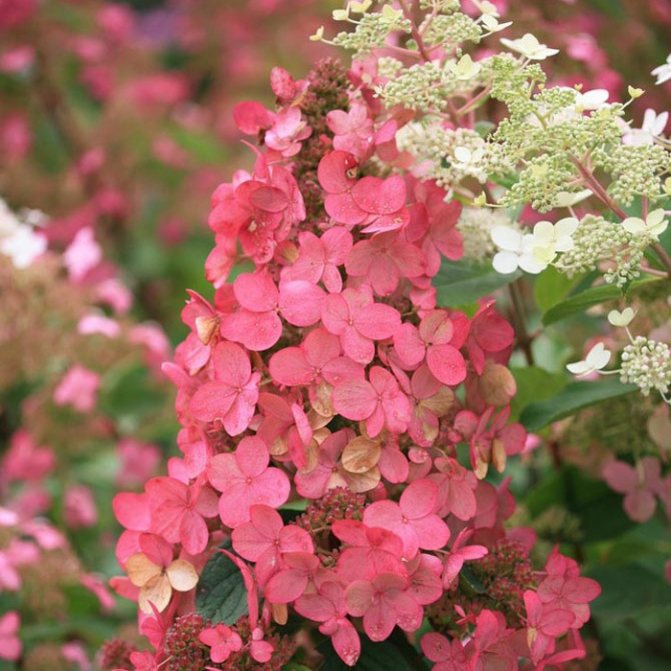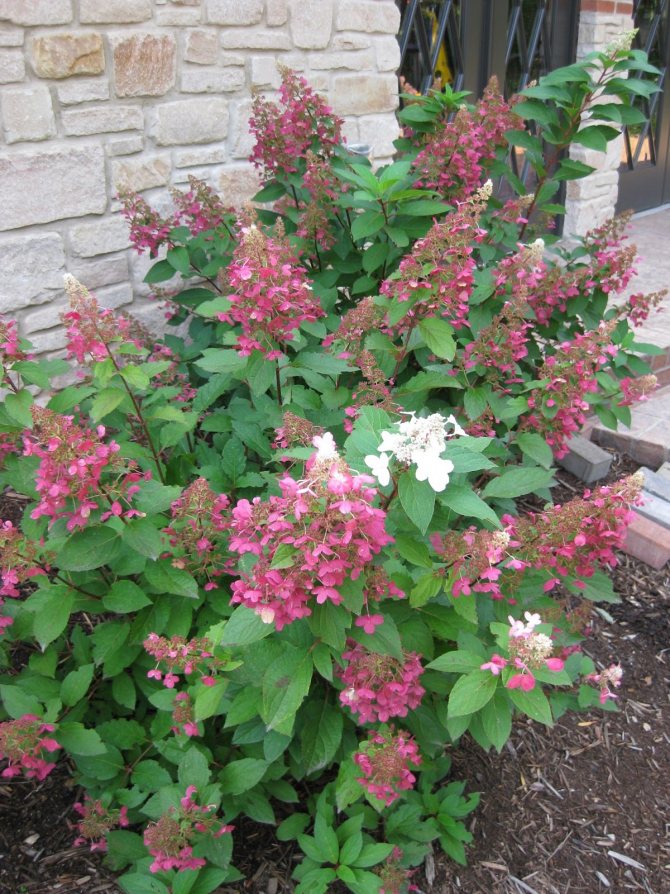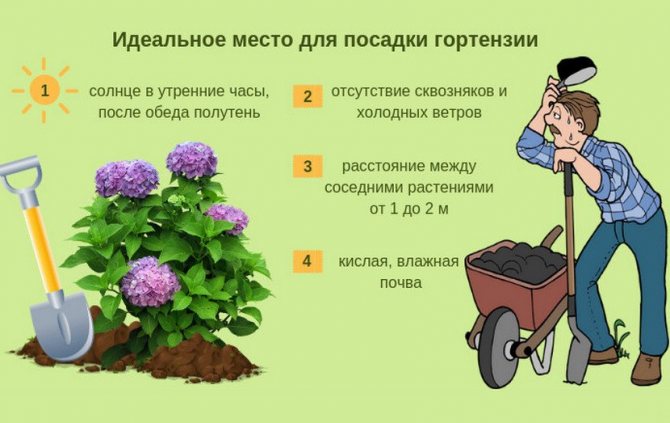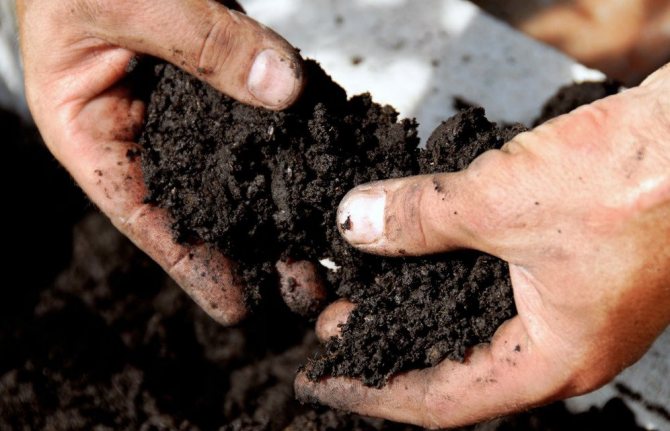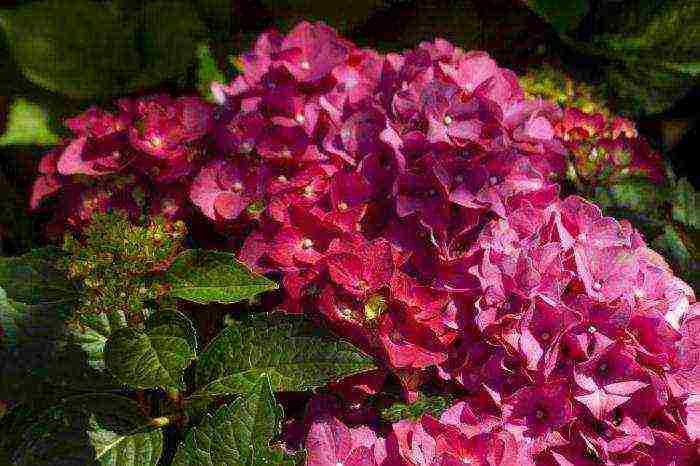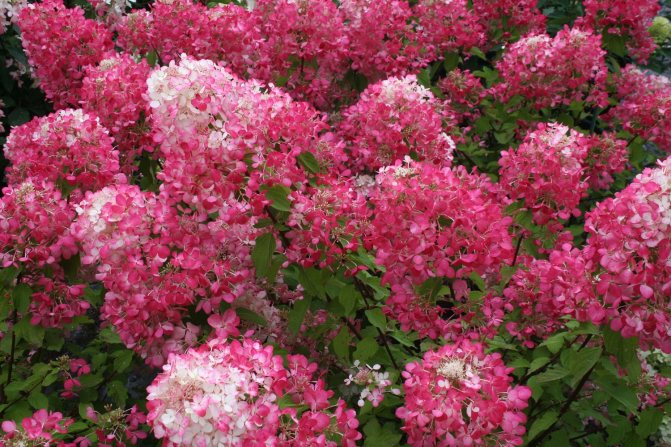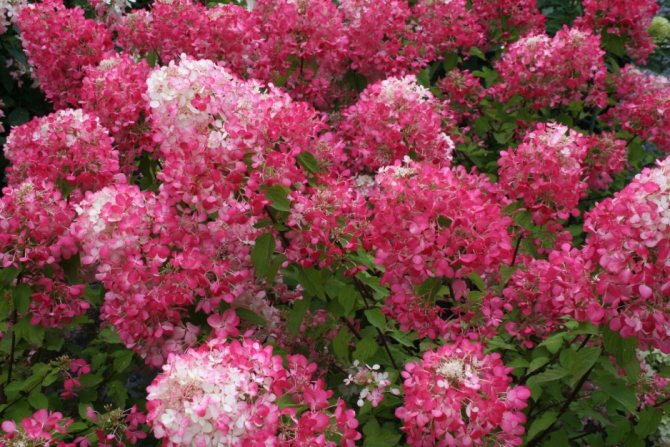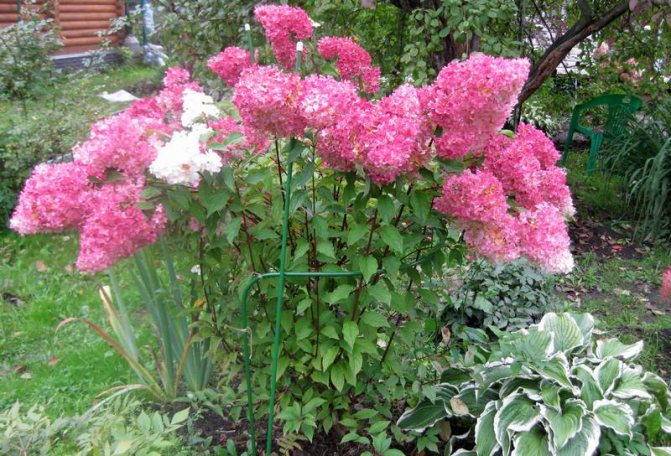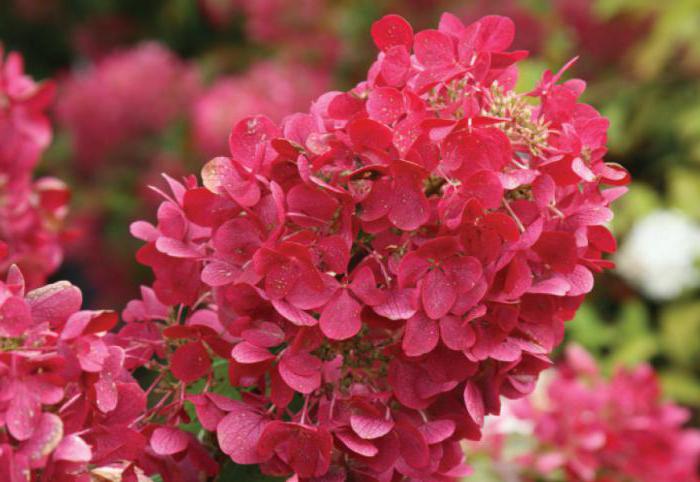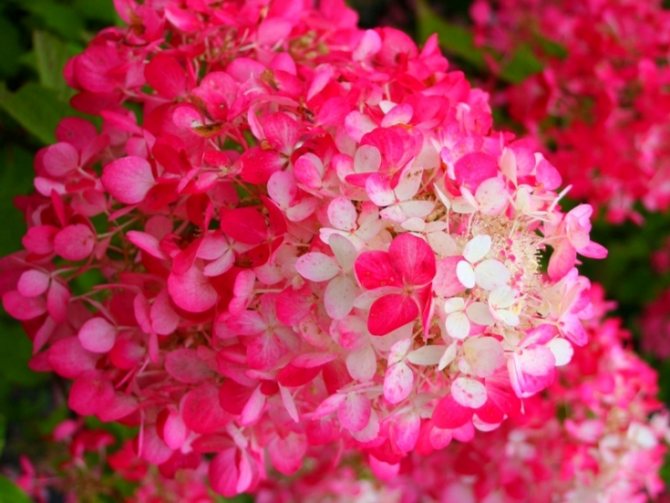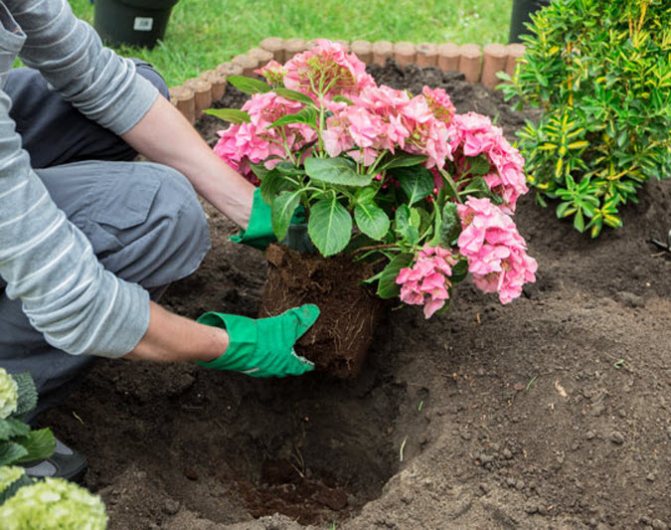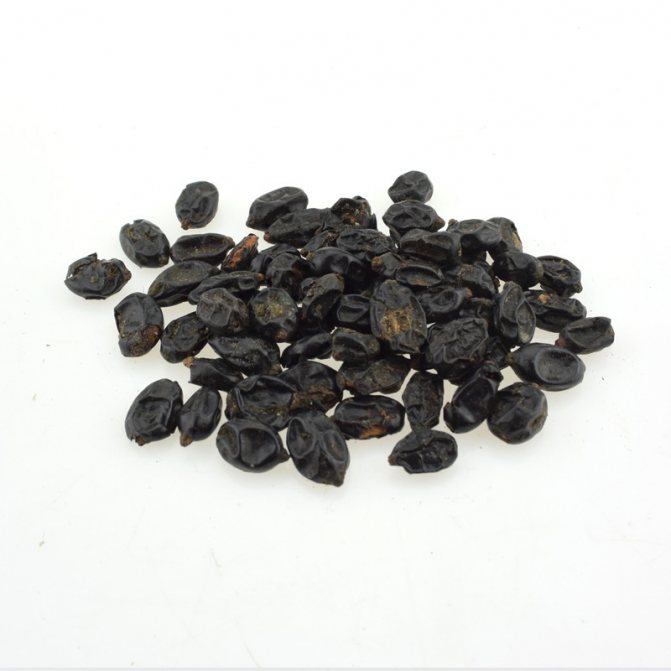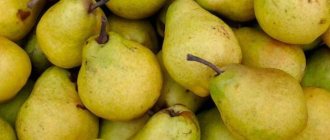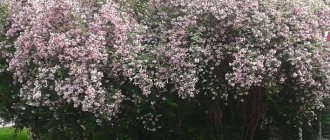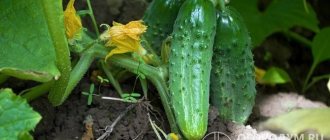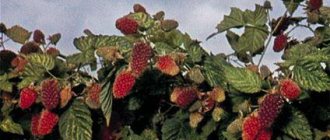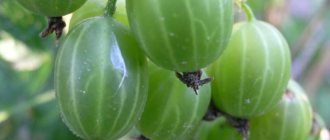Loading ...
Among garden panicle hydrangeas, there are many varieties with bright and long flowering. These include the large Pink Diamond variety and the smaller, more compact Diamond Rouge.
With their brightly colored pink and red blossoms, these plants bring life to the landscape of the infield.
But not only because of the beautiful flowering, these varieties have gained such popularity. They are unpretentious and frost-resistant, it is not difficult to take care of them. And with proper care, this shrub lives for several decades.
In the article you will learn everything about the care and planting of hydrangea paniculata Diamond Pink and Rouge.
Description of the variety
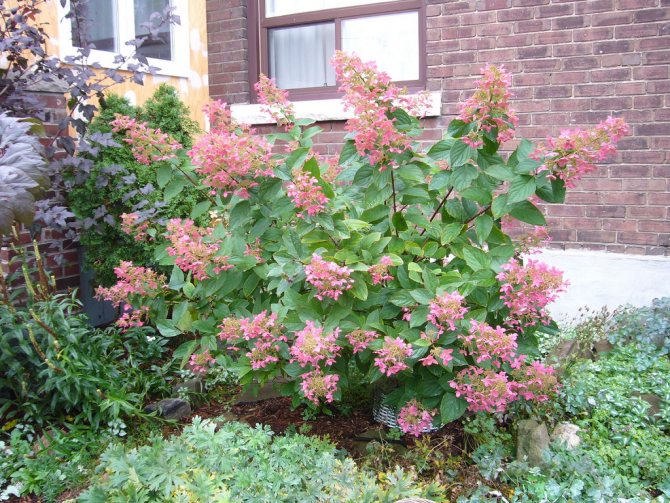
Hydrangea Pink Diamond
Hydrangea paniculata Pink Diamond is one of the long-known varieties. For several centuries it has been used for decorative purposes. It is distinguished by its attractive appearance and neatness. All this despite its size - it can reach 3 meters in height.
Attention! Inexperienced gardeners sometimes call the hydrangea variety Pink Diamant. This is a misnomer.
Shoots of Pink Diamond hydrangea are characterized by resistance. They hardly break under the gusts of wind. In case of mechanical damage, they are easily restored. This shrub is resistant to low temperatures and does not die during severe frosts. The life span of a plant can be up to 30 years. As the branches of the hydrangea grow, they gain more and more strength.
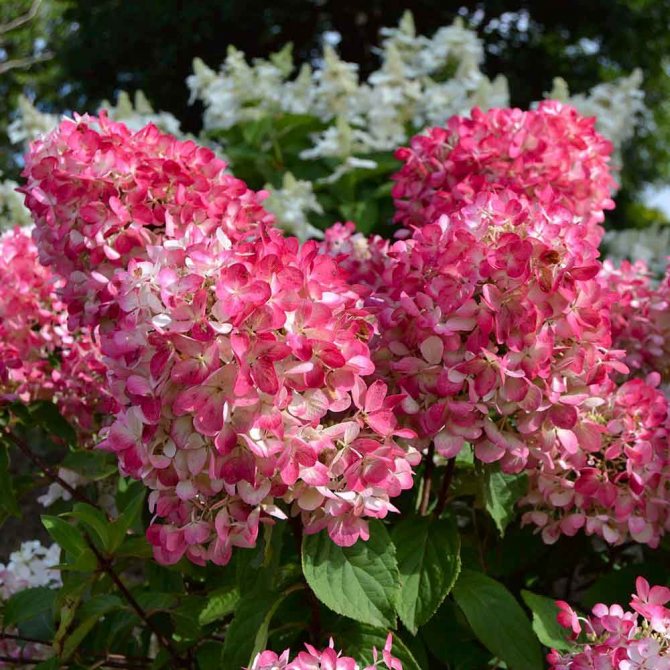

Shoots of Pink Diamond hydrangea
The leaves of the Pink Diamond hydrangea are elliptical. They are rough to the touch and have a matte green color.
The shrub is characterized by a neat appearance even in the absence of the necessary maintenance and pruning, since it branches little. But caring summer residents are able to give it any shape.
Hydrangea inflorescences look like a large cone 15-30 cm in size. They bloom in early July and remain until mid-September. The plant is interesting in that its flowers can change color. In summer, the buds are white, but gradually acquire a rich color and by autumn they become dark pink or lilac. The plant blooms very profusely, due to which the bush is covered with clusters of small flowers.
Choosing a place for planting and preparing the soil
The plant is considered light-loving. However, it may well develop in the shadows. The amount of sunlight directly affects the splendor of the flowering of the bush.
The culture develops well when planted in clay and loamy soil, which should be fertile enough. In this case, hydrangeas require an acidic or neutral environment. This will ensure quality flowering.
In sandy soil, the plant cannot develop normally. To provide the culture with nutrients, whey can be used. To acidify the soil, you can add peat, needles, sawdust to it.
Features of planting hydrangeas
Hydrangea Diamond Rouge - description, planting and care
It is important to know not only the description of the Pink Diamond hydrangea, but also the features of its planting, since the life of the plant and its attractiveness depend on them.
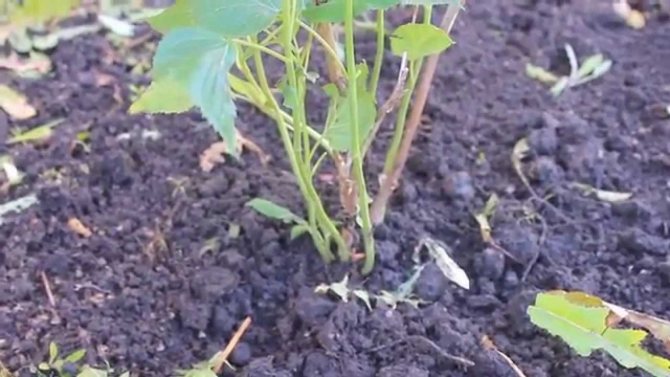

Features of planting hydrangeas
Before planting a plant, you need to find a suitable place:
- The culture grows to a height of 2 m.Therefore, enough space is needed for the hydrangea to grow in height and width.
- This type of hydrangea is shade-loving. For disembarkation, it is necessary to select dimly lit areas.
- The preferred type of soil is moderately acidic.
This shrub is easily adaptable to different conditions, so the requirements listed above are not strict. Hydrangea Pink diamond can grow in the shade and on insufficiently fertile soil. But she needs high humidity, so you need to ensure frequent watering.
The culture is planted in two ways: cuttings and seeds.
When using seeds, make sure they are of good quality. It is advisable to choose those that are delivered from Japan or China, since there are the most natural conditions for the growth of hydrangeas. The seeds should be dark brown, small in size and oblong in shape. Units that are stained or damaged are not suitable for disembarkation. Each hydrangea seed should be clean and firm.
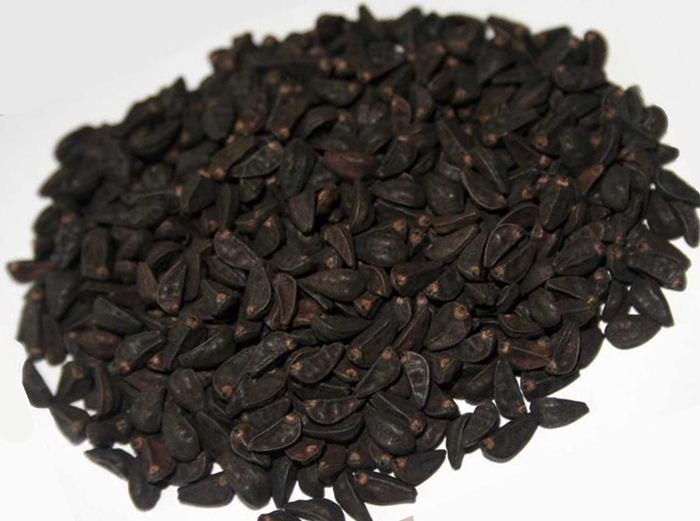

Hydrangea seeds
It is worth planting a plant in the fall. Hydrangea seeds need to be placed in a special substrate consisting of 3 components: leaf and turf soil, plus sand. The proportions of the components are 4: 2: 1. The prepared substrate is placed in bags and disembarked.
This culture needs frequent moisture to grow. The optimum soil temperature is up to 20 degrees. The first shoots of hydrangea should appear in about a month and a half. When 2-3 leaves are formed on them, you can transplant the seedlings into separate pots, the diameter of which should be at least 7 cm.
In the summer, the presence of seedlings in the fresh air is allowed. You need to protect them from drafts, rain and direct sunlight. Hydrangea can be transplanted into open ground after 3 years.
Important! The entire period from planting seeds to transplanting into the ground should not be allowed to bloom. It is necessary to cut off the peduncles before they begin to actively grow.
Hydrangea cuttings are planted in early spring, summer and autumn. They need to be located at a distance from each other (about 1 m). When preparing the pits, you should make them large in size. They must exceed the root system several times. A fertile mixture purchased from a store is placed at the bottom of each. The roots of the plant must be completely covered with soil. Lightly compact the earth and water. It is also necessary to mulch with sawdust or plant residues.
Transplant after purchase in open ground
To transplant a pink diamond into open ground, the grafting method is used. You can transplant it in the spring, summer or fall. Spring is considered the most suitable time for transplanting, in which case the hydrangea will bloom in a few months.
What is needed for landing
Hydrangea Pink Lady (Hydrangea Paniculata Pink Lady) - description
For planting shrubs, you need to prepare the soil. The soil should contain leafy earth, humus, river sand and peat chips in proportions (2: 2: 1: 1). Fertile soil, good drainage, systematic soil fertilization are suitable for this variety of hydrangea.
Attention! For fast growth and a healthy appearance of the plant, ash and lime must be excluded from the soil. The acid-base balance of the soil should be from 5.0 to 6.5.
Optimal location
Pink Diamond hydrangea is a light-loving plant, but open sun and wind are undesirable for it. Therefore, it is better to choose a shaded area protected from the wind for planting. A place with only sun in the morning is also suitable.
If a shrub is planted in a vacant lot, then it will grow more in breadth, while its height will be small.
Step-by-step planting process
The process of disembarking a panicle lady consists of the following stages:
- The root system of the shrub is located in the upper soil layer, therefore, a hole 30-50 cm deep should be made in the ground.
- The diameter of the hole must be larger than the size of the roots.
- The minimum distance between seedlings is 1 m. If the grower prefers a trench planting method, then in this case there should be about 3 m between the seedlings. 10-15 liters of water must be poured into each hole.
- When placing a seedling in the hole, the roots must not be bent upwards, they should lie flat.
- After placing the seedling in the hole, the entire root system is covered with a mixture of soil with a fertile substrate from a mixture of peat, needles and humus. The neck of the root should remain at the level of the ground cover. The ground around the seedling is lightly tamped and watered abundantly.
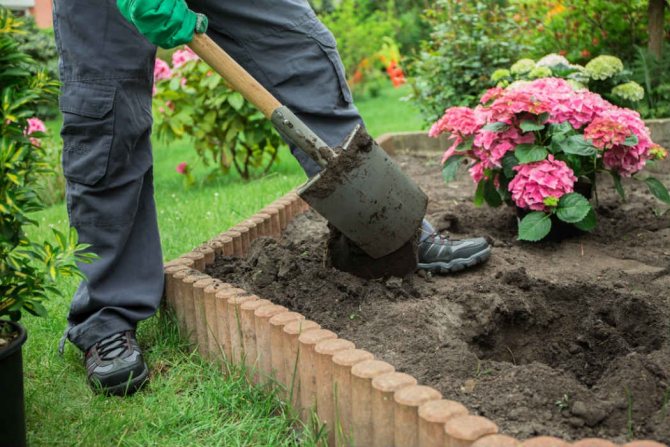

The seedling was sprinkled with soil
- On top of the compacted layer of soil, you need to apply a layer of mulch from chips, sawdust, grass, leaves. This is necessary to retain moisture in the upper soil layer. In addition, mulch inhibits the growth of weeds and attacks by insect pests.
Additional Information. For active growth and good condition of the plant, you can use fresh or dry manure, about 7 kilograms for each seedling. This condition is not necessary for the paniculate beauty to please the owner with her irresistibility.
Care features
Hydrangea Pink Diamond does not need special care, but it is better to take into account a number of requirements, otherwise the plant will grow slowly, and its flowers will become small and faded.
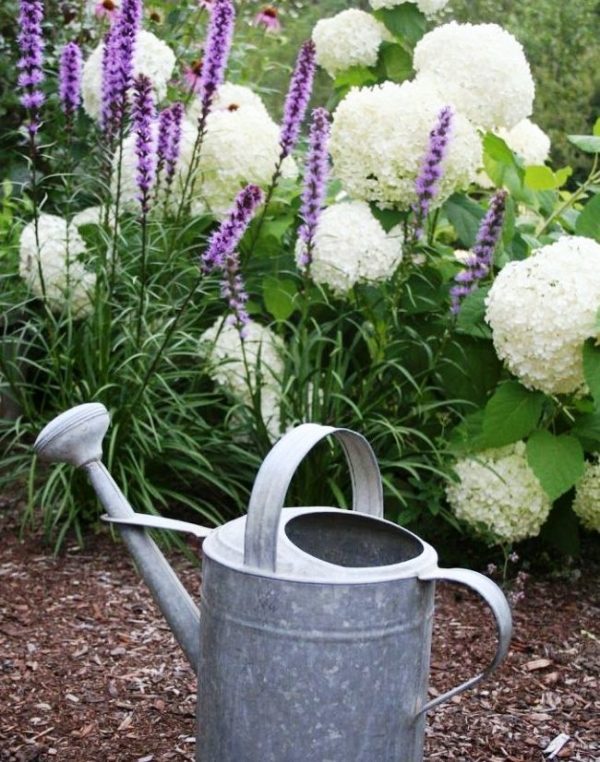

Watering hydrangea
Hydrangea Pink Lady: variety description, planting and care
This crop needs frequent watering, especially during the growing season. At this time, the moisture consumption of the root system increases and there is a risk of drying out. Therefore, the soil must be moist. It is best to water the plant with a solution of potassium permanganate - this will provide not only moisture, but also a beautiful flowering of the culture.
Top dressing is carried out with fertilizers and mineral additives. Hydrangea needs them in the spring, with active sap flow. The most commonly used chalk and peat. Dry or fresh manure can be used. Also, this plant responds well to the addition of food products to the soil, for example, whey or kefir. The use of lemon juice diluted with water helps from the yellowness of the flowers. Spraying shrubs with iron sulfate helps to prevent the leaves from drying out.
Important! Nitrogen-based fertilizers must be used very carefully, as excess of this substance is harmful to hydrangeas.
If the soil is rich enough in minerals, you can not be zealous with feeding.
Hydrangea pruning is carried out to give a beautiful appearance. During this work, weak and damaged branches are removed. It is recommended to shorten strong stems, leaving up to 5 buds on them. This must be done in the fall.
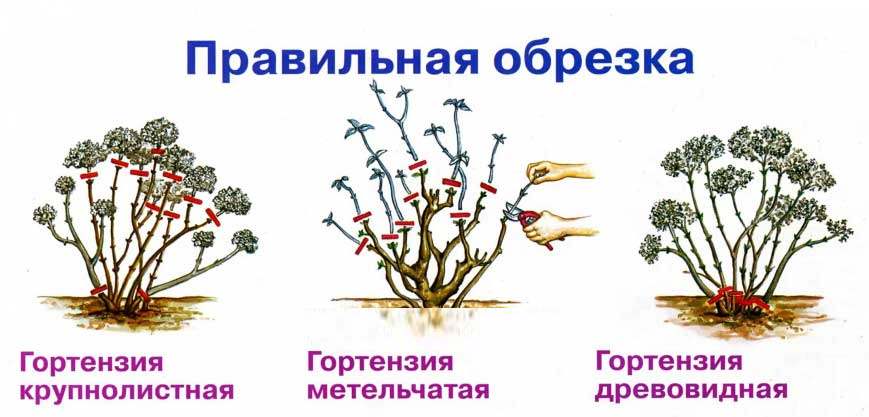

Pruning hydrangea
This culture is frost-hardy, but it is worth hiding for the winter, especially in the first year. The ground around the bush is covered with burlap or film, and the stems are bent and also covered. A layer of peat is laid on top, over which pieces of slate are placed. In this form, the plant copes with temperatures up to 30 degrees below zero. Frozen shoots almost always return to normal, so in warm and temperate climates it is not necessary to hide them for the winter.
For mulching hydrangeas, sawdust and needles are used.
Let's summarize
Let's briefly dwell on all the features and subtleties:
- Hydrangea Pink Diamond is an incredibly beautiful, fragrant, unpretentious, hardy and frost-resistant plant;
- for planting, it is better to use shaded and wind-protected areas with acidic soil;
- if the landing site is well lit, you need to take care of protecting the plant from direct sunlight;
- bushes are planted in spring or autumn;
- Pink Diamond requires abundant watering and does not tolerate drying out of the soil;
- the shrub reacts well to fertilization;
- pruning of the plant is periodically required in order to remove weak and deformed shoots;
- timely spraying of hydrangea paniculata will save the plant from diseases and pests.
Hydrangea Pink Diamond is a real decoration of any site. The ease of planting and maintenance makes the variety very competitive among its fellows. Following our recommendations will allow you to easily grow a bright and strong plant, adding a colorful touch to the garden.
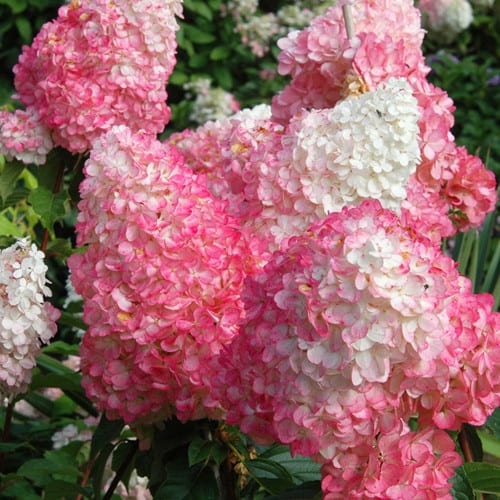

Diseases and pests
The Pink Diamond panicle hydrangea is an unpretentious plant that easily adapts to adverse conditions. But he also has some types of diseases.
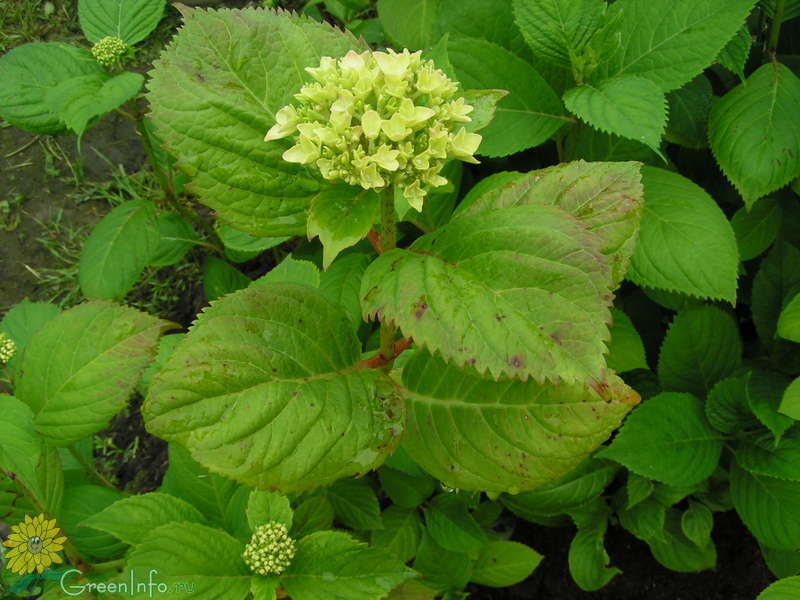

Hydrangea diseases
Hydrangea Incredible tree - description, planting and care
Common problems with growing this crop are powdery mildew and garden aphids. Because of them, the hydrangea can die or lose its strength and attractiveness. To avoid this, the bushes are treated in advance with the help of Avixil, Vitaxid, Oksikhom preparations. They help to avoid diseases and destroy pests.
You can also use folk remedies. The most popular is the use of a solution of laundry soap and garlic. Soap (250 g) is diluted in water (2 l) and 50 g of garlic are added there. Shrubs should be sprayed with this mixture 2-3 times a week shortly before flowering. Such a remedy is very effective against harmful insects.
On a note! This culture is one of the most hardy, because it easily overcomes the impact of adverse circumstances. Because of this feature, the plant has become so popular.
Top dressing and fertilizers
Like any plant, the Pink Diamond hydrangea requires periodic feeding and fertilization. Traditionally used:
- dolomite flour;
- a piece of chalk;
- peat or humus;
- pine needles;
- urea;
- potassium sulfate;
- slurry;
- superphosphate;
- nitroammophos.
Advice! You need to feed it three times per season; in spring, summer and autumn.
Of the popular methods, it is worth noting the effectiveness of using fermented milk products: kefir, yogurt and whey. They are diluted with water in a 1: 3 ratio. Bread dressing provides intensive growth and abundant flowering. Organic fertilizers are spread in a layer of 10-15 cm around shrubs in the autumn. This will serve as fertilizer and additional insulation of plantings.
Use in garden decoration
The main advantages of hydrangea are its hardiness and ease of care. Therefore, the plant is so often used to decorate garden and backyard plots. Another important feature is its beauty and the duration of flowering, during which the color of the inflorescences changes from white to red.
Hydrangea bushes can be planted in the center of flower beds with smaller plants. But it must be remembered that this culture actively consumes moisture, which can cause its neighbors to dry out. Therefore, the neighbors must be selected from among the drought tolerant plants. Hydrangea Pink Diamond goes well with small conifers. By planting them side by side, you can create a wonderful contrast that makes the garden alley unique. Hydrangeas also look good along with cereals, verbena and clematis.
When using this shrub to decorate a garden or summer cottage, it must be borne in mind that it does not combine with plants of orange, yellow and red colors. Therefore, they should be located in different zones.
Pink Diamond hydrangea looks good on its own - surrounded by fruit trees. The shrub can be given its original shape by pruning - this will be an interesting element of landscape design.
Breeding methods for paniculate hydrangea
Violet CM Amadeus pink - description and characteristics of the variety
There are 3 breeding options:
- cuttings;
- layering;
- dividing the bush.
Green cuttings are obtained from the upper shoots.To begin with, they are placed in the sand, and after a couple of months they are transplanted into a pot with earth. Since the best time to collect cuttings is the beginning of summer, they need to be hidden indoors for the winter, and transplanted into open ground in the spring.
Reproduction with the help of layering occurs before bud break. A small depression is made in the ground, the lower shoots are laid out there and covered with soil. Regular watering of the buried twigs is required. Only after a year is it possible to separate the shoot from the mother bush and plant it in another place.
When dividing a bush, it is necessary to dig up a bush in warm weather and divide its roots into parts. The resulting lobes are washed, trimmed and planted in prepared places.
Gardeners reviews
Almost in all regions of our country today, hydrangea Diamond Rouge paniculata is grown. Reviews about this luxurious plant can be read in almost all floriculture publications. Exquisite flowering of huge inflorescences, fairly simple care, an excellent combination in landscape design with other plants, high winter hardiness - these are the qualities for which the Diamond Rouge (hydrangea) is valued by gardeners. This plant has minor drawbacks - the need for winter shelter in the northern regions and a great need for moisture, which does not allow the plant to be left for a long time (for example, when leaving on vacation).
Pruning
Hydrangea Diamond Rouge needs annual pruning. Thanks to this procedure, the plant will retain its attractiveness for a long time and bloom for a long time, delighting the gardener. In the fall, it is necessary to cut off all the remaining inflorescences, weak and old branches growing inside the bush from the bush. It is recommended to leave no more than twelve strong shoots for the winter.
Spring pruning is done before the buds bloom. The shoots of an adult plant are cut into two or three buds, a young one - into three to five. This will allow the bush to gain strength over the summer. The flowering becomes more intense and lush. Spring pruning is usually combined with top dressing.
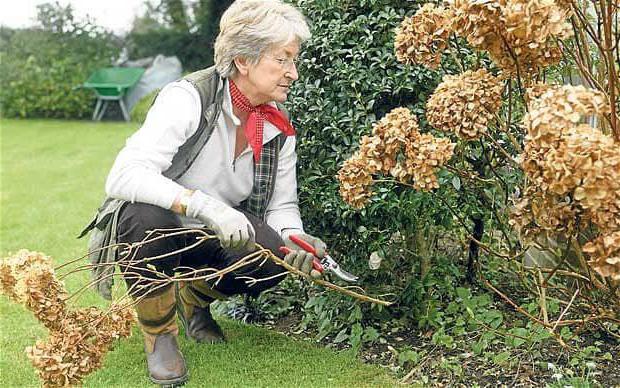

Old hydrangea bushes require rejuvenation. To do this, the shoots must be cut under the stump. In two years, the bush will fully recover.
Origin and appearance
Among the numerous species, the panicle hydrangea diamant rouge occupies a special place. It was recently bred by French breeders and has since enjoyed great success at numerous exhibitions. One of the most beautiful views, which is confirmed by a large number of awards and medals. The new variety is frost-resistant and unpretentious. Its name translates as "red diamond".
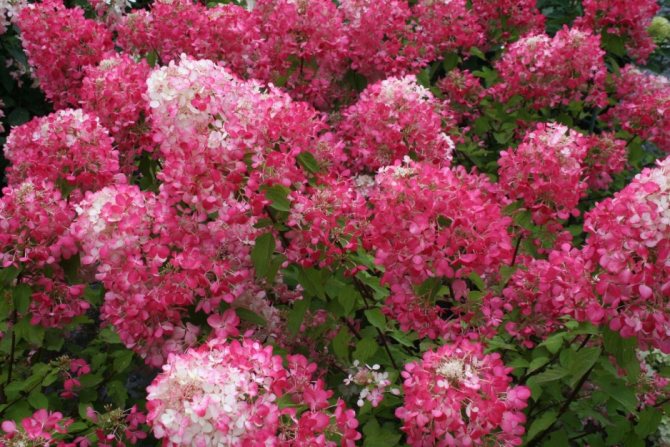

Hydrangea in bloom
This is a very beautiful shrub 1.5-2 m high. Its luxurious crown is covered with large red flowers and reaches 1.2-1.5 m. It blooms almost all summer, delighting with a variety of colors. The saturation of shades depends on the type of soil, climate, area.
Rouge hydrangea leaves are elongated with a velvety surface. They have unusual shades: from juicy green to orange-red, which makes the bush even more beautiful. The root system of the plant is wide and spreads close to the surface.
When describing the flowers of hydrangea diamond paniculata, first of all, it is necessary to mention their characteristic feature of changing color from white at the beginning of flowering to pink, and later bright red. Graceful flowers are collected in inflorescences in the form of panicles 30-40 cm long.

